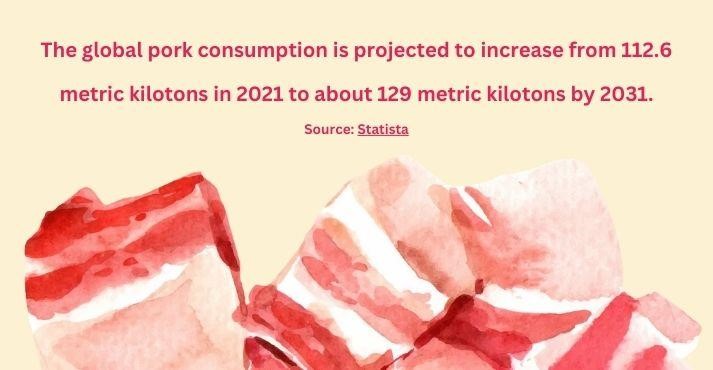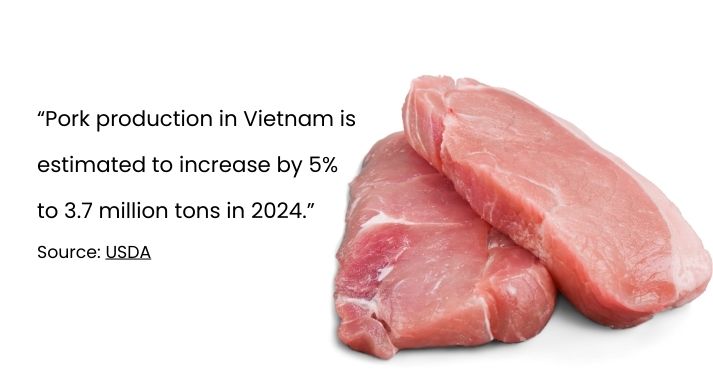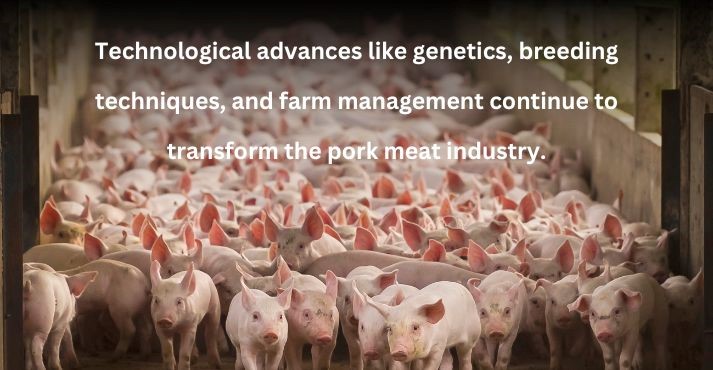Global demand for meat is growing.
Pork is the most widely and popular consumed meat source worldwide. The pork meat market is projected to register a CAGR of 5.7% over the next five years.
Due to its versatility, affordability, and widespread consumer appeal, the pork meat industry continues to evolve, enhancing culinary options. The pork meat market analysis indicates that the demand has been rising substantially with several new trends and challenges that will continue to expand sales numbers and growth.
This blog will discuss the following aspects of the pork meat market.
- Key Trends in the Pork Meat Market
- Major Players in the Pork Meat Market
- Market Drivers and Challenges
- Impact of Technology on Pork Meat Production
- Future Outlook
Key Trends in the Pork Meat Market
The pork market reports reveal that the market is set to experience steady growth, driven by continuous technological advancements, consumption patterns, changing trade dynamics, and rising demand for meat production.
Let’s explore the key meat sector trends that will lead to new opportunities and market growth.
Consumption Patterns

As a popular protein source, pork contributes substantially to global meat consumption. Global pork consumption is projected to increase from 112.6 metric kilotons in 2021 to about 129.3 metric kilotons by 2032.
Pork is cheaper than any other meat source, which is a significant factor in its high consumption.
Traditional pork-heavy diets in regions like Asia-Pacific are gradually diversifying, with a rising interest in healthier and more sustainable protein sources.
Plant-based and lab-grown meat products are gaining traction, challenging the dominance of conventional pork. The industry adapts to these changing preferences with innovation and sustainability.
Moreover, wine pairing preferences are also experiencing shifts to complement changing consumer choices. With a growing focus on healthier and leaner pork cuts, there’s an increased demand for lighter, more acidic wines to balance the flavors.
Production and Supply
The demand for pork meat continues to hold strong worldwide.
However, the supply chain needs to improve due to fluctuations in the global export market. Weather conditions and natural disasters impact feed crops, affecting pig farming. Fluctuations in feed prices and input costs directly influence production expenses.
Regulatory policies, including food safety standards and animal welfare regulations, will shape the future of production practices. The global economic conditions, trade agreements, and geopolitical events impact pork exports and imports, further influencing supply dynamics.
Moreover, as consumer demand remains high and steady, the demand for pork meat continues to surge due to the market’s current pricing volatility.
The interplay of these factors creates a dynamic environment, requiring the pork industry to adapt and innovate to ensure a stable and sustainable supply.
Trade Dynamics

The global pork meat market exhibits dynamic trade trends driven by changing consumer preferences, economic conditions, and geopolitical influences.
Trade tensions, tariff fluctuations, and disease outbreaks can impact pork exports, creating ripple effects across the supply chain. Additionally, food safety practices to prevent biological hazards also influence trade patterns.
China is predicted to be the leading pork import country worldwide, including other countries such as Japan, Mexico, the UK, South Korea, the Philippines, the US, Hong Kong, Australia, Canada, and others.
According to the US Department of Agriculture (USDA), pork production in Vietnam is estimated to increase by 5% to 3.7 million tons in 2024, mainly due to increased domestic demand for pork meat after the post-COVID-19 economic recovery.
Major Players in the Pork Meat Market
The pork meat market is highly competitive and includes regional and international players. Companies are developing new products to maintain their presence in the pork meat market.
The major players in the pork meat market are:
- China Yurun Food Group
- Tyson Foods
- Danish Crown
- JBS
- WH Group
- SuperValu
- BRF
- Bridgford Foods Corporation
- Coca Foods
- Craig Mostyn Group
- KEPAK
Market Drivers and Challenges
The pig meat market is expected to experience substantial expansion over the next several years.
The growth of the pork meat market can be attributed to several drivers, such as affordability, taste, and versatility. Meanwhile, the market is concerned with the challenges the pork meat market faces, such as disease outbreaks, ethical concerns, and environmental impact.
Market Drivers
Let’s explore the key market driver in the swine meat industry:
1. Affordability
Pork is often more affordable than other meats, making it a popular choice for budget-conscious consumers. Its cost-effectiveness appeals to a wide demographic, contributing significantly to the growth of the pork meat market.
2. Taste and palatability
Pork is known for its versatile and appealing taste. Its ability to absorb flavors makes it a favorite in various cuisines, enhancing consumer satisfaction.
3. Versatility in cooking styles
Whether grilled, roasted, or stewed, pork offers diverse culinary possibilities. Versatility attracts consumers seeking variety and convenience, fueling growth in the pork meat market.
4. Health benefits
With growing awareness of the importance of a balanced diet, consumers seek nutritious meat options. Pork is a good source of essential nutrients like protein, vitamins, and minerals.
5. Cultural preferences
Cultural ties and traditions contribute to the sustained growth of the pork meat market. This preference drives consistent demand from countries worldwide.
Market Challenges
Here are some of the critical challenges faced by the pork meat industry:
1. Disease outbreaks
Frequent disease outbreaks, such as swine flu or African swine fever, pose a significant challenge to the pork meat market. These outbreaks can lead to mass culling, trade restrictions, and consumer concerns, impacting supply and demand.
2. Ethical concerns
Increasing awareness of animal welfare issues and ethical considerations in meat production can challenge the pork industry. Consumers are now demanding for humane and sustainable practices.
3. Environmental Impact
Growing environmental awareness may lead consumers to seek more sustainable and eco-friendly alternatives, challenging conventional practices within the pork meat market. Pork production includes environmental issues like deforestation for feed crops and waste management.
4. The rise of plant-based diets
The increasing popularity of plant-based meat challenges the pork meat market. As more consumers adopt vegan or plant-based lifestyles for health, there’s a potential shift away from traditional pork meat consumption.
5. Global trade uncertainties
Trade disruptions affect the export and import of pork products, influencing market dynamics and posing challenges for producers, distributors, and retailers in the pork meat market.
Impact of Technology on Pork Meat Production

Big data combined with artificial intelligence algorithms, resulting in foodtech, is changing the dynamics of pork meat production. Technological advancements are revolutionizing the pork industry, enhancing efficiency and sustainability.
Reproductive technologies in pork production have changed areas such as pigs produced/sow, more consistent pig flow to market, pig growth rate and feed efficiency, carcass yield and quality, labor efficiency, and pig health.
Some of the critical innovations in farming, processing, and distribution include:
- Precision farming: Utilizing IoT sensors and data analytics for optimized pig farming, monitoring health, and ensuring efficient resource use.
- Cellular agriculture: Cultivating pork from cells in labs, reducing environmental impact, and addressing ethical concerns.
- Smart processing: Automation and robotics in meat processing plants enhance efficiency, reduce labor, and improve product consistency.
- Blockchain traceability: Implementing blockchain to track and verify the entire pork supply chain, ensuring transparency, food safety, and quality assurance.
- Alternative feeds: Developing sustainable and nutritious alternatives to traditional pig feeds, reducing environmental impact, and addressing resource constraints.
Digital technologies are rising, and we will see pork meat producers and manufacturers transition from farming pigs to farming data. The emerging technologies in the pork industry include augmented reality, artificial intelligence, three-dimensional (3D) printing, and the Internet of Things.
Future Outlook
Pork will continue to dominate the meat industry.
Systems of pork production changed from forest-based to pasture-based to dirt lots and finally into specially-designed buildings. Sustainable production methods are being implemented.
Led by the use of big data and the application of tools available in machine learning, the pork meat market will invest in data collection, management, and deployment.
Health-conscious consumers may drive demand for leaner pork varieties, while sustainable and ethical production practices will gain importance. Also, novel plant-based alternatives might gain traction, challenging traditional consumption patterns.
Technological innovations, like cultured or lab-grown meat, could reshape production methods, addressing environmental and ethical concerns. Moreover, personalized nutrition trends may drive demand for tailored pork products.
Pork Meat Market Analysis (FAQs)
What is the CAGR of the Pork Meat Market?
The pork meat market is expected to grow at a CAGR of 3.8% from 2021-2027.
What are the segments of the Pork Meat Market?
The pork meat market segment includes:
- Fresh pork
- Processed pork
- Pork sausages
- Bacon
- Ham
- Other pork cuts
Conclusion
Driven by increasing consumer demand, technological advancements, and evolving dietary preferences, the pork meat market analysis indicates that the market exhibits a promising landscape.
Affordability, versatility, and nutritional value contribute to pork’s popularity. Emerging trends like sustainable and ethically sourced products gain traction, influencing purchasing decisions.
However, challenges like disease outbreaks and supply chain disruptions underscore the importance of resilience in the market. Strategic partnerships, innovation, and market responsiveness will help key players in the pork meat industry grow amid a changing landscape.





























